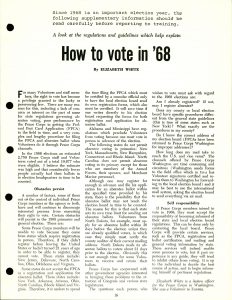At the time of writing, the 2022 midterm elections are approaching, and many Americans (this author included) are making their preparations to vote by mail. For decades, Peace Corps Volunteers have been among the voters who need to use mail-in ballots. This included Susan Anderson, who served from 1968-1972 in Malawi and Mali. Before she even reported for training, the Peace Corps sent her an article, included in the January 1968 edition of the Peace Corps Volunteer, to explain the process of voting overseas. Written by Elizabeth White, a Peace Corps employee and former Volunteer, the article “How to vote in ‘68” attempted to lay out both the importance of and obstacles to voting.

“How to vote in ’68,” by Elizabeth White. This article highlights the difficulties of voting overseas for Peace Corps Volunteers.
Voting by Mail in 1968
White’s article is only meant to be a brief introduction to mail-in voting for Volunteers who were or would be overseas for the primary or general elections that year. It includes encouragement to raise the very low number of Peace Corps Volunteer votes from 1964 and provides key information geared towards first time voters. (In 1968, the minimum voting age was still 21, so a large number of Volunteers would not have voted before starting their service.) However, White’s main point was the self-responsibility of each Volunteer- every state and locality had slightly different rules, and most greatly restricted the participation of overseas or otherwise absentee voters. For example, six states required voter registration in person, so any unregistered Volunteers from these states who were already training or serving could not vote at all. Seven states did not accept the Federal Post Card Application (the federal forms to permit voting overseas), so Volunteers from these states were warned not to waste time filling out these forms and contact their state and local governments directly. Five states had either partial or total restrictions on mail-in voting for primaries. Alabama and Mississippi directly prohibited mail-in voting if a Volunteer had never voted in person before. White also acknowledged that there were several other restrictions and deadlines on a state-by-state level. She noted that, at the end of the day, Volunteers had to decide for themselves if all of these restrictions were too prohibitive to attempt voting. [1]
Voting by Mail Today
In the years since, federal and state governments have made changes that have made it easier for Peace Corps Volunteers to vote by mail during their service. While many states still have various levels of restrictions for voting by mail, several of these laws provide exceptions for those overseas, including Volunteers. [2] The federal government has passed several different rounds of voting-related legislation, which has also smoothed this process. Most important was the Uniformed and Overseas Citizens Absentee Voting Act, passed in 1986, and amended by the Military and Overseas Voter Empowerment Act in 2009 (though only fifteen states have fully implemented the amendment). This legislation allows members of the U.S. military and other U.S. citizens living abroad to vote in federal elections and receive their ballots forty-five days before an election. [3] Today, the Peace Corps continues to help Volunteers vote, and they include necessary information and forms on their website.[4] While access to voting overseas and in the Peace Corps has changed since 1968, the importance of voting has not. So don’t forget to cast your vote this November in person, absentee, or by mail!
[1] Summary from Elizabeth White, “How to vote in ’68,” Peace Corps Volunteer, Vol. 7 No. 3 (January 1968), 16, American University Archives, Washington, D.C.
[2] Information from “Absentee Ballot Rules,” Vote.org, https://www.vote.org/absentee-voting-rules/. Accessed September 27, 2022. For anyone looking for voting resources, Vote.org is a great place to start.
[3] “The Uniformed and Overseas Citizens Absentee Voting Act,” The United States Department of Justice, last updated February 18, 2020, https://www.justice.gov/crt/uniformed-and-overseas-citizens-absentee-voting-act; “Military and Overseas Voter Empowerment (MOVE) Act,” Ballotpedia, https://ballotpedia.org/Military_and_Overseas_Voter_Empowerment_(MOVE)_Act, accessed October 4, 2022.
[4] “Voting Assistance,” Peace Corps, https://www.peacecorps.gov/voting-assistance/, accessed October 4, 2022.
